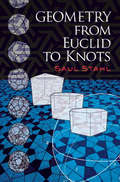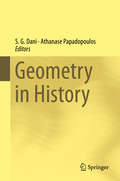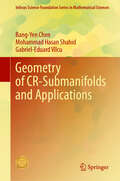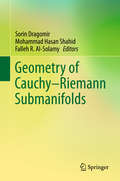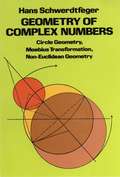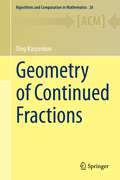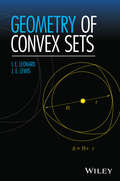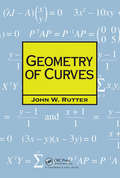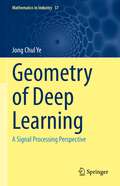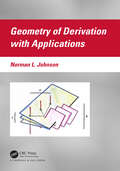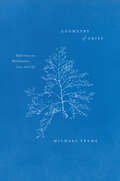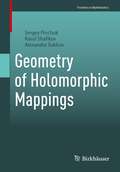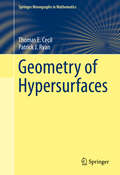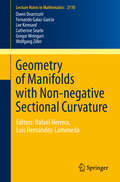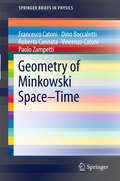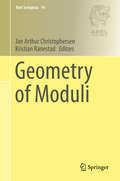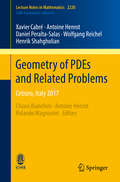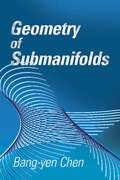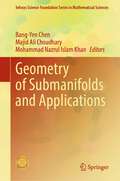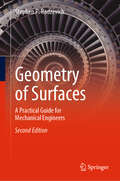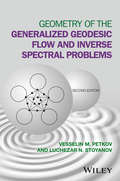- Table View
- List View
Geometry from Euclid to Knots: From Euclid To Knots (Dover Books on Mathematics)
by Saul StahlDesigned to inform readers about the formal development of Euclidean geometry and to prepare prospective high school mathematics instructors to teach Euclidean geometry, this text closely follows Euclid's classic, Elements. The text augments Euclid's statements with appropriate historical commentary and many exercises -- more than 1,000 practice exercises provide readers with hands-on experience in solving geometrical problems. In addition to providing a historical perspective on plane geometry, this text covers non-Euclidean geometries, allowing students to cultivate an appreciation of axiomatic systems. Additional topics include circles and regular polygons, projective geometry, symmetries, inversions, knots and links, graphs, surfaces, and informal topology. This republication of a popular text is substantially less expensive than prior editions and offers a new Preface by the author.
Geometry from a Differentiable Viewpoint
by John McclearyThe development of geometry from Euclid to Euler to Lobachevsky, Bolyai, Gauss, and Riemann is a story that is often broken into parts - axiomatic geometry, non-Euclidean geometry, and differential geometry. This poses a problem for undergraduates: Which part is geometry? What is the big picture to which these parts belong? In this introduction to differential geometry, the parts are united with all of their interrelations, motivated by the history of the parallel postulate. Beginning with the ancient sources, the author first explores synthetic methods in Euclidean and non-Euclidean geometry and then introduces differential geometry in its classical formulation, leading to the modern formulation on manifolds such as space-time. The presentation is enlivened by historical diversions such as Hugyens's clock and the mathematics of cartography. The intertwined approaches will help undergraduates understand the role of elementary ideas in the more general, differential setting. This thoroughly revised second edition includes numerous new exercises and a new solution key. New topics include Clairaut's relation for geodesics, Euclid's geometry of space, further properties of cycloids and map projections, and the use of transformations such as the reflections of the Beltrami disk.
Geometry in History
by Athanase Papadopoulos S. G. DaniThis is a collection of surveys on important mathematical ideas, their origin, their evolution and their impact in current research. The authors are mathematicians who are leading experts in their fields. The book is addressed to all mathematicians, from undergraduate students to senior researchers, regardless of the specialty.
Geometry in a Fréchet Context: A Projective Limit Approach
by C. T. J. Dodson George Galanis Efstathios VassiliouMany geometrical features of manifolds and fibre bundles modelled on Fréchet spaces either cannot be defined or are difficult to handle directly. This is due to the inherent deficiencies of Fréchet spaces; for example, the lack of a general solvability theory for differential equations, the non-existence of a reasonable Lie group structure on the general linear group of a Fréchet space, and the non-existence of an exponential map in a Fréchet-Lie group. In this book, the authors describe in detail a new approach that overcomes many of these limitations by using projective limits of geometrical objects modelled on Banach spaces. It will appeal to researchers and graduate students from a variety of backgrounds with an interest in infinite-dimensional geometry. The book concludes with an appendix outlining potential applications and motivating future research.
Geometry of CR-Submanifolds and Applications (Infosys Science Foundation Series)
by Mohammad Hasan Shahid Bang-Yen Chen Gabriel-Eduard VîlcuThis book attempts to present a comprehensive survey of the geometry of CR-submanifolds. The theory of submanifolds is one of the most interesting topics in differential geometry. The topic is introduced by Aurel Bejancu as a generalization of holomorphic and totally real submanifolds of almost Hermitian manifolds, in 1978. Afterward, the study of CR-submanifolds became a very active research subject. Organized into 22 chapters, the book starts with basic knowledge of Riemannian manifolds and submanifolds, almost Hermitian manifolds and their subclasses, Hopf fibration, symmetric spaces, and a general inequality for submanifolds in complex space forms (in Chaps. 1 and 2). Later, it presents the main results on CR-submanifolds in Kaehler manifolds, the basic inequalities associated with CR-submanifolds in Kaehler manifolds, and several theories and results related to Kaehler manifolds (in Chaps. 3–11). Further, the book discusses the basics of almost-contact metric manifolds and their subclasses, CR-submanifolds of Sasakian, trans-Sasakian and quasi-Sasakian manifolds, with a particular attention on the normal CR-submanifolds (in Chap. 12). It also investigates the contact CR-submanifolds of S-manifolds, the geometry of submersions of CR-submanifolds, and the results on contact CR-warped product submanifolds (in Chaps. 16–18, 20). In Chapter 19, we discuss submersions of CR-submanifolds. The book also presents some recent results concerning CR-submanifolds of holomorphic statistical manifolds. In particular, it gives the classification of totally umbilical CR-statistical submanifolds in holomorphic statistical manifolds, as well as a Chen–Ricci inequality for such submanifolds (Chapter 21). In the last chapter, we present results on CR-submanifolds of indefinite Kaehler manifolds and their applications to physics.
Geometry of Cauchy-Riemann Submanifolds
by Sorin Dragomir Mohammad Hasan Shahid Falleh R. Al-SolamyThis book gathers contributions by respected experts on the theory of isometric immersions between Riemannian manifolds, and focuses on the geometry of CR structures on submanifolds in Hermitian manifolds. CR structures are a bundle theoretic recast of the tangential Cauchy-Riemann equations in complex analysis involving several complex variables. The book covers a wide range of topics such as Sasakian geometry, Kaehler and locally conformal Kaehler geometry, the tangential CR equations, Lorentzian geometry, holomorphic statistical manifolds, and paraquaternionic CR submanifolds. Intended as a tribute to Professor Aurel Bejancu, who discovered the notion of a CR submanifold of a Hermitian manifold in 1978, the book provides an up-to-date overview of several topics in the geometry of CR submanifolds. Presenting detailed information on the most recent advances in the area, it represents a useful resource for mathematicians and physicists alike.
Geometry of Complex Numbers
by Hans SchwerdtfegerSince its initial publication in 1962, Professor Schwerdtfeger's illuminating book has been widely praised for generating a deeper understanding of the geometrical theory of analytic functions as well as of the connections between different branches of geometry. Its focus lies in the intersection of geometry, analysis, and algebra, with the exposition generally taking place on a moderately advanced level. Much emphasis, however, has been given to the careful exposition of details and to the development of an adequate algebraic technique.In three broad chapters, the author clearly and elegantly approaches his subject. The first chapter, Analytic Geometry of Circles, treats such topics as representation of circles by Hermitian matrices, inversion, stereographic projection, and the cross ratio. The second chapter considers in depth the Moebius transformation: its elementary properties, real one-dimensional projectivities, similarity and classification of various kinds, anti-homographies, iteration, and geometrical characterization. The final chapter, Two-Dimensional Non-Euclidean Geometries, discusses subgroups of Moebius transformations, the geometry of a transformation group, hyperbolic geometry, and spherical and elliptic geometry. For this Dover edition, Professor Schwerdtfeger has added four new appendices and a supplementary bibliography.Advanced undergraduates who possess a working knowledge of the algebra of complex numbers and of the elements of analytical geometry and linear algebra will greatly profit from reading this book. It will also prove a stimulating and thought-provoking book to mathematics professors and teachers.
Geometry of Continued Fractions
by Oleg KarpenkovTraditionally a subject of number theory, continued fractions appear in dynamical systems, algebraic geometry, topology, and even celestial mechanics. The rise of computational geometry has resulted in renewed interest in multidimensional generalizations of continued fractions. Numerous classical theorems have been extended to the multidimensional case, casting light on phenomena in diverse areas of mathematics. This book introduces a new geometric vision of continued fractions. It covers several applications to questions related to such areas as Diophantine approximation, algebraic number theory, and toric geometry. The reader will find an overview of current progress in the geometric theory of multidimensional continued fractions accompanied by currently open problems. Whenever possible, we illustrate geometric constructions with figures and examples. Each chapter has exercises useful for undergraduate or graduate courses.
Geometry of Convex Sets
by J. E. Lewis I. E. LeonardA gentle introduction to the geometry of convex sets in n-dimensional space Geometry of Convex Sets begins with basic definitions of the concepts of vector addition and scalar multiplication and then defines the notion of convexity for subsets of n-dimensional space. Many properties of convex sets can be discovered using just the linear structure. However, for more interesting results, it is necessary to introduce the notion of distance in order to discuss open sets, closed sets, bounded sets, and compact sets. The book illustrates the interplay between these linear and topological concepts, which makes the notion of convexity so interesting. Thoroughly class-tested, the book discusses topology and convexity in the context of normed linear spaces, specifically with a norm topology on an n-dimensional space. Geometry of Convex Sets also features: An introduction to -dimensional geometry including points; lines; vectors; distance; norms; inner products; orthogonality; convexity; hyperplanes; and linear functionals Coverage of n-dimensional norm topology including interior points and open sets; accumulation points and closed sets; boundary points and closed sets; compact subsets of n-dimensional space; completeness of n-dimensional space; sequences; equivalent norms; distance between sets; and support hyperplanes Basic properties of convex sets; convex hulls; interior and closure of convex sets; closed convex hulls; accessibility lemma; regularity of convex sets; affine hulls; flats or affine subspaces; affine basis theorem; separation theorems; extreme points of convex sets; supporting hyperplanes and extreme points; existence of extreme points; Krein-Milman theorem; polyhedral sets and polytopes; and Birkhoff's theorem on doubly stochastic matrices Discussions of Helly's theorem; the Art Gallery theorem; Vincensini's problem; Hadwiger's theorems; theorems of Radon and Caratheodory; Kirchberger's theorem; Helly-type theorems for circles; covering problems; piercing problems; sets of constant width; Reuleaux triangles; Barbier's theorem; and Borsuk's problem Geometry of Convex Sets is a useful textbook for upper-undergraduate level courses in geometry of convex sets and is essential for graduate-level courses in convex analysis. An excellent reference for academics and readers interested in learning the various applications of convex geometry, the book is also appropriate for teachers who would like to convey a better understanding and appreciation of the field to students. I. E. Leonard, PhD, was a contract lecturer in the Department of Mathematical and Statistical Sciences at the University of Alberta. The author of over 15 peer-reviewed journal articles, he is a technical editor for the Canadian Applied Mathematical Quarterly journal. J. E. Lewis, PhD, is Professor Emeritus in the Department of Mathematical Sciences at the University of Alberta. He was the recipient of the Faculty of Science Award for Excellence in Teaching in 2004 as well as the PIMS Education Prize in 2002.
Geometry of Curves (Chapman Hall/CRC Mathematics Series)
by J.W. RutterInterest in the study of geometry is currently enjoying a resurgence-understandably so, as the study of curves was once the playground of some very great mathematicians. However, many of the subject's more exciting aspects require a somewhat advanced mathematics background. For the "fun stuff" to be accessible, we need to offer students an introduction with modest prerequisites, one that stimulates their interest and focuses on problem solving.Integrating parametric, algebraic, and projective curves into a single text, Geometry of Curves offers students a unique approach that provides a mathematical structure for solving problems, not just a catalog of theorems. The author begins with the basics, then takes students on a fascinating journey from conics, higher algebraic and transcendental curves, through the properties of parametric curves, the classification of limaçons, envelopes, and finally to projective curves, their relationship to algebraic curves, and their application to asymptotes and boundedness.The uniqueness of this treatment lies in its integration of the different types of curves, its use of analytic methods, and its generous number of examples, exercises, and illustrations.The result is a practical text, almost entirely self-contained, that not only imparts a deeper understanding of the theory, but inspires a heightened appreciation of geometry and interest in more advanced studies.
Geometry of Deep Learning: A Signal Processing Perspective (Mathematics in Industry #37)
by Jong Chul YeThe focus of this book is on providing students with insights into geometry that can help them understand deep learning from a unified perspective. Rather than describing deep learning as an implementation technique, as is usually the case in many existing deep learning books, here, deep learning is explained as an ultimate form of signal processing techniques that can be imagined. To support this claim, an overview of classical kernel machine learning approaches is presented, and their advantages and limitations are explained. Following a detailed explanation of the basic building blocks of deep neural networks from a biological and algorithmic point of view, the latest tools such as attention, normalization, Transformer, BERT, GPT-3, and others are described. Here, too, the focus is on the fact that in these heuristic approaches, there is an important, beautiful geometric structure behind the intuition that enables a systematic understanding. A unified geometric analysis to understand the working mechanism of deep learning from high-dimensional geometry is offered. Then, different forms of generative models like GAN, VAE, normalizing flows, optimal transport, and so on are described from a unified geometric perspective, showing that they actually come from statistical distance-minimization problems.Because this book contains up-to-date information from both a practical and theoretical point of view, it can be used as an advanced deep learning textbook in universities or as a reference source for researchers interested in acquiring the latest deep learning algorithms and their underlying principles. In addition, the book has been prepared for a codeshare course for both engineering and mathematics students, thus much of the content is interdisciplinary and will appeal to students from both disciplines.
Geometry of Derivation with Applications
by Norman L. JohnsonGeometry of Derivation with Applications is the fifth work in a longstanding series of books on combinatorial geometry (Subplane Covered Nets, Foundations of Translation Planes, Handbook of Finite Translation Planes, and Combinatorics of Spreads and Parallelisms). Like its predecessors, this book will primarily deal with connections to the theory of derivable nets and translation planes in both the finite and infinite cases. Translation planes over non-commutative skewfields have not traditionally had a significant representation in incidence geometry, and derivable nets over skewfields have only been marginally understood. Both are deeply examined in this volume, while ideas of non-commutative algebra are also described in detail, with all the necessary background given a geometric treatment. The book builds upon over twenty years of work concerning combinatorial geometry, charted across four previous books and is suitable as a reference text for graduate students and researchers. It contains a variety of new ideas and generalizations of established work in finite affine geometry and is replete with examples and applications.
Geometry of Grief: Reflections on Mathematics, Loss, and Life
by Michael Frame&“With poignancy and audacity, Frame builds an unexpected bridge between mathematical beauty and human sorrow, illuminating both.&” —Francis Su, author of Mathematics for Human Flourishing We all know the euphoria of intellectual epiphany—the thrill of sudden understanding. But coupled with that excitement is a sense of loss: a moment of epiphany can never be repeated. In Geometry of Grief,mathematician Michael Frame draws on a career&’s worth of insight—including his work with a pioneer of fractal geometry Benoit Mandelbrot—as he delves into this understanding of loss. Grief, Frame reveals, can be a moment of possibility. Frame investigates grief as a response to an irrevocable change in circumstance. This reframing allows us to see parallels between the loss of a loved one and the loss of the elation of first understanding a tricky concept. From this foundation, Frame builds a geometric model of mental states. An object that is fractal, for example, has symmetry of magnification: magnify a picture of a mountain or a fern leaf—both fractal—and we see echoes of the original shape. Similarly, nested inside great loss are smaller losses. By manipulating this geometry, Frame shows us, we may be able to redirect our thinking in ways that help reduce our pain. Small-scale losses, in essence, provide laboratories to learn how to meet large-scale losses. Interweaving original illustrations, clear introductions to advanced topics in geometry, and wisdom gleaned from his own experience, Frame&’s poetic book is a journey through the beautiful complexities of mathematics and life. &“Intriguing.&” —Nature &“Poignant and beautiful. &“ —Steven Strogatz, New York Time– bestselling author of Infinite Powers &“A wonderful memoir.&” —Choice
Geometry of Holomorphic Mappings (Frontiers in Mathematics)
by Sergey Pinchuk Rasul Shafikov Alexandre SukhovThis monograph explores the problem of boundary regularity and analytic continuation of holomorphic mappings between domains in complex Euclidean spaces. Many important methods and techniques in several complex variables have been developed in connection with these questions, and the goal of this book is to introduce the reader to some of these approaches and to demonstrate how they can be used in the context of boundary properties of holomorphic maps. The authors present substantial results concerning holomorphic mappings in several complex variables with improved and often simplified proofs. Emphasis is placed on geometric methods, including the Kobayashi metric, the Scaling method, Segre varieties, and the Reflection principle. Geometry of Holomorphic Mappings will provide a valuable resource for PhD students in complex analysis and complex geometry; it will also be of interest to researchers in these areas as a reference.
Geometry of Hypersurfaces
by Thomas E. Cecil Patrick J. RyanThis exposition provides the state-of-the art on the differential geometry of hypersurfaces in real, complex, and quaternionic space forms. Special emphasis is placed on isoparametric and Dupin hypersurfaces in real space forms as well as Hopf hypersurfaces in complex space forms. The book is accessible to a reader who has completed a one-year graduate course in differential geometry. The text, including open problems and an extensive list of references, is an excellent resource for researchers in this area. Geometry of Hypersurfaces begins with the basic theory of submanifolds in real space forms. Topics include shape operators, principal curvatures and foliations, tubes and parallel hypersurfaces, curvature spheres and focal submanifolds. The focus then turns to the theory of isoparametric hypersurfaces in spheres. Important examples and classification results are given, including the construction of isoparametric hypersurfaces based on representations of Clifford algebras. An in-depth treatment of Dupin hypersurfaces follows with results that are proved in the context of Lie sphere geometry as well as those that are obtained using standard methods of submanifold theory. Next comes a thorough treatment of the theory of real hypersurfaces in complex space forms. A central focus is a complete proof of the classification of Hopf hypersurfaces with constant principal curvatures due to Kimura and Berndt. The book concludes with the basic theory of real hypersurfaces in quaternionic space forms, including statements of the major classification results and directions for further research.
Geometry of Manifolds with Non-negative Sectional Curvature
by Owen Dearricott Fernando Galaz-García Lee Kennard Catherine Searle Gregor Weingart Wolfgang ZillerProviding an up-to-date overview of the geometry of manifolds with non-negative sectional curvature, this volume gives a detailed account of the most recent research in the area. The lectures cover a wide range of topics such as general isometric group actions, circle actions on positively curved four manifolds, cohomogeneity one actions on Alexandrov spaces, isometric torus actions on Riemannian manifolds of maximal symmetry rank, n-Sasakian manifolds, isoparametric hypersurfaces in spheres, contact CR and CR submanifolds, Riemannian submersions and the Hopf conjecture with symmetry. Also included is an introduction to the theory of exterior differential systems.
Geometry of Minkowski Space-Time
by Dino Boccaletti Paolo Zampetti Vincenzo Catoni Roberto Cannata Francesco CatoniThis book provides an original introduction to the geometry of Minkowski space-time. A hundred years after the space-time formulation of special relativity by Hermann Minkowski, it is shown that the kinematical consequences of special relativity are merely a manifestation of space-time geometry. The book is written with the intention of providing students (and teachers) of the first years of University courses with a tool which is easy to be applied and allows the solution of any problem of relativistic kinematics at the same time. The book treats in a rigorous way, but using a non-sophisticated mathematics, the Kinematics of Special Relativity. As an example, the famous "Twin Paradox" is completely solved for all kinds of motions. The novelty of the presentation in this book consists in the extensive use of hyperbolic numbers, the simplest extension of complex numbers, for a complete formalization of the kinematics in the Minkowski space-time. Moreover, from this formalization the understanding of gravity comes as a manifestation of curvature of space-time, suggesting new research fields.
Geometry of Moduli (Abel Symposia #14)
by Jan Arthur Christophersen Kristian RanestadThe proceedings from the Abel Symposium on Geometry of Moduli, held at Svinøya Rorbuer, Svolvær in Lofoten, in August 2017, present both survey and research articles on the recent surge of developments in understanding moduli problems in algebraic geometry. Written by many of the main contributors to this evolving subject, the book provides a comprehensive collection of new methods and the various directions in which moduli theory is advancing. These include the geometry of moduli spaces, non-reductive geometric invariant theory, birational geometry, enumerative geometry, hyper-kähler geometry, syzygies of curves and Brill-Noether theory and stability conditions. Moduli theory is ubiquitous in algebraic geometry, and this is reflected in the list of moduli spaces addressed in this volume: sheaves on varieties, symmetric tensors, abelian differentials, (log) Calabi-Yau varieties, points on schemes, rational varieties, curves, abelian varieties and hyper-Kähler manifolds.
Geometry of PDEs and Related Problems: Cetraro, Italy 2017 (Lecture Notes in Mathematics #2220)
by Rolando Magnanini Xavier Cabré Antoine Henrot Daniel Peralta-Salas Wolfgang Reichel Henrik Shahgholian Chiara BianchiniThe aim of this book is to present different aspects of the deep interplay between Partial Differential Equations and Geometry. It gives an overview of some of the themes of recent research in the field and their mutual links, describing the main underlying ideas, and providing up-to-date references.Collecting together the lecture notes of the five mini-courses given at the CIME Summer School held in Cetraro (Cosenza, Italy) in the week of June 19–23, 2017, the volume presents a friendly introduction to a broad spectrum of up-to-date and hot topics in the study of PDEs, describing the state-of-the-art in the subject. It also gives further details on the main ideas of the proofs, their technical difficulties, and their possible extension to other contexts. Aiming to be a primary source for researchers in the field, the book will attract potential readers from several areas of mathematics.
Geometry of Quantum States: An Introduction to Quantum Entanglement
by Ingemar Bengtsson Karol ŻyczkowskiQuantum information theory is a branch of science at the frontier of physics, mathematics, and information science, and offers a variety of solutions that are impossible using classical theory. This book provides a detailed introduction to the key concepts used in processing quantum information and reveals that quantum mechanics is a generalisation of classical probability theory. The second edition contains new sections and entirely new chapters: the hot topic of multipartite entanglement; in-depth discussion of the discrete structures in finite dimensional Hilbert space, including unitary operator bases, mutually unbiased bases, symmetric informationally complete generalized measurements, discrete Wigner function, and unitary designs; the Gleason and Kochen-Specker theorems; the proof of the Lieb conjecture; the measure concentration phenomenon; and the Hastings' non-additivity theorem. This richly-illustrated book will be useful to a broad audience of graduates and researchers interested in quantum information theory. Exercises follow each chapter, with hints and answers supplied.
Geometry of Submanifolds (Dover Books on Mathematics)
by Bang-Yen ChenThe first two chapters of this frequently cited reference provide background material in Riemannian geometry and the theory of submanifolds. Subsequent chapters explore minimal submanifolds, submanifolds with parallel mean curvature vector, conformally flat manifolds, and umbilical manifolds. The final chapter discusses geometric inequalities of submanifolds, results in Morse theory and their applications, and total mean curvature of a submanifold.Suitable for graduate students and mathematicians in the area of classical and modern differential geometries, the treatment is largely self-contained. Problems sets conclude each chapter, and an extensive bibliography provides background for students wishing to conduct further research in this area. This new edition includes the author's corrections.
Geometry of Submanifolds and Applications (Infosys Science Foundation Series)
by Bang-Yen Chen Majid Ali Choudhary Mohammad Nazrul Islam KhanThis book features chapters written by renowned scientists from various parts of the world, providing an up-to-date survey of submanifold theory, spanning diverse topics and applications. The book covers a wide range of topics such as Chen–Ricci inequalities in differential geometry, optimal inequalities for Casorati curvatures in quaternion geometry, conformal η-Ricci–Yamabe solitons, submersion on statistical metallic structure, solitons in f(R, T)-gravity, metric-affine geometry, generalized Wintgen inequalities, tangent bundles, and Lagrangian submanifolds.Moreover, the book showcases the latest findings on Pythagorean submanifolds and submanifolds of four-dimensional f-manifolds. The chapters in this book delve into numerous problems and conjectures on submanifolds, providing valuable insights for scientists, educators, and graduate students looking to stay updated with the latest developments in the field. With its comprehensive coverage and detailed explanations, this book is an essential resource for anyone interested in submanifold theory.
Geometry of Surfaces: A Practical Guide for Mechanical Engineers
by Stephen P. RadzevichThis updated and expanded edition presents a highly accurate specification for part surface machining. Precise specification reduces the cost of this widely used industrial operation as accurately specified and machined part surfaces do not need to undergo costly final finishing. Dr. Radzevich describes techniques in this volume based primarily on classical differential geometry of surfaces. He then transitions from differential geometry of surfaces to engineering geometry of surfaces, and examines how part surfaces are either machined themselves, or are produced by tools with surfaces that are precisely machined. The book goes on to explain specific methods, such as derivation of planar characteristic curves based on Plücker conoid constructed at a point of the part surface, and that analytical description of part surface is vital for surfaces machined using CNC technology, and especially so for multi-axes NC machines. Providing readers with a powerful tool for analytical description of part surfaces machined on conventional machine tools and numerically controlled machines, this book maximizes understanding on optimal treatment of part surfaces to meet the requirements of today’s high tech industry.
Geometry of the Generalized Geodesic Flow and Inverse Spectral Problems
by Luchezar N. Stoyanov Vesselin M. PetkovThis book is a new edition of a title originally published in1992. No other book has been published that treats inverse spectral and inverse scattering results by using the so called Poisson summation formula and the related study of singularities. This book presents these in a closed and comprehensive form, and the exposition is based on a combination of different tools and results from dynamical systems, microlocal analysis, spectral and scattering theory.The content of the first edition is still relevant, however the new edition will include several new results established after 1992; new text will comprise about a third of the content of the new edition. The main chapters in the first edition in combination with the new chapters will provide a better and more comprehensive presentation of importance for the applications inverse results. These results are obtained by modern mathematical techniques which will be presented together in order to give the readers the opportunity to completely understand them. Moreover, some basic generic properties established by the authors after the publication of the first edition establishing the wide range of applicability of the Poison relation will be presented for first time in the new edition of the book.
Geometry of the Phase Retrieval Problem: Graveyard of Algorithms (Cambridge Monographs on Applied and Computational Mathematics)
by Charles L. Epstein Alexander H. Barnett Leslie Greengard Jeremy MaglandRecovering the phase of the Fourier transform is a ubiquitous problem in imaging applications from astronomy to nanoscale X-ray diffraction imaging. Despite the efforts of a multitude of scientists, from astronomers to mathematicians, there is, as yet, no satisfactory theoretical or algorithmic solution to this class of problems. Written for mathematicians, physicists and engineers working in image analysis and reconstruction, this book introduces a conceptual, geometric framework for the analysis of these problems, leading to a deeper understanding of the essential, algorithmically independent, difficulty of their solutions. Using this framework, the book studies standard algorithms and a range of theoretical issues in phase retrieval and provides several new algorithms and approaches to this problem with the potential to improve the reconstructed images. The book is lavishly illustrated with the results of numerous numerical experiments that motivate the theoretical development and place it in the context of practical applications.
